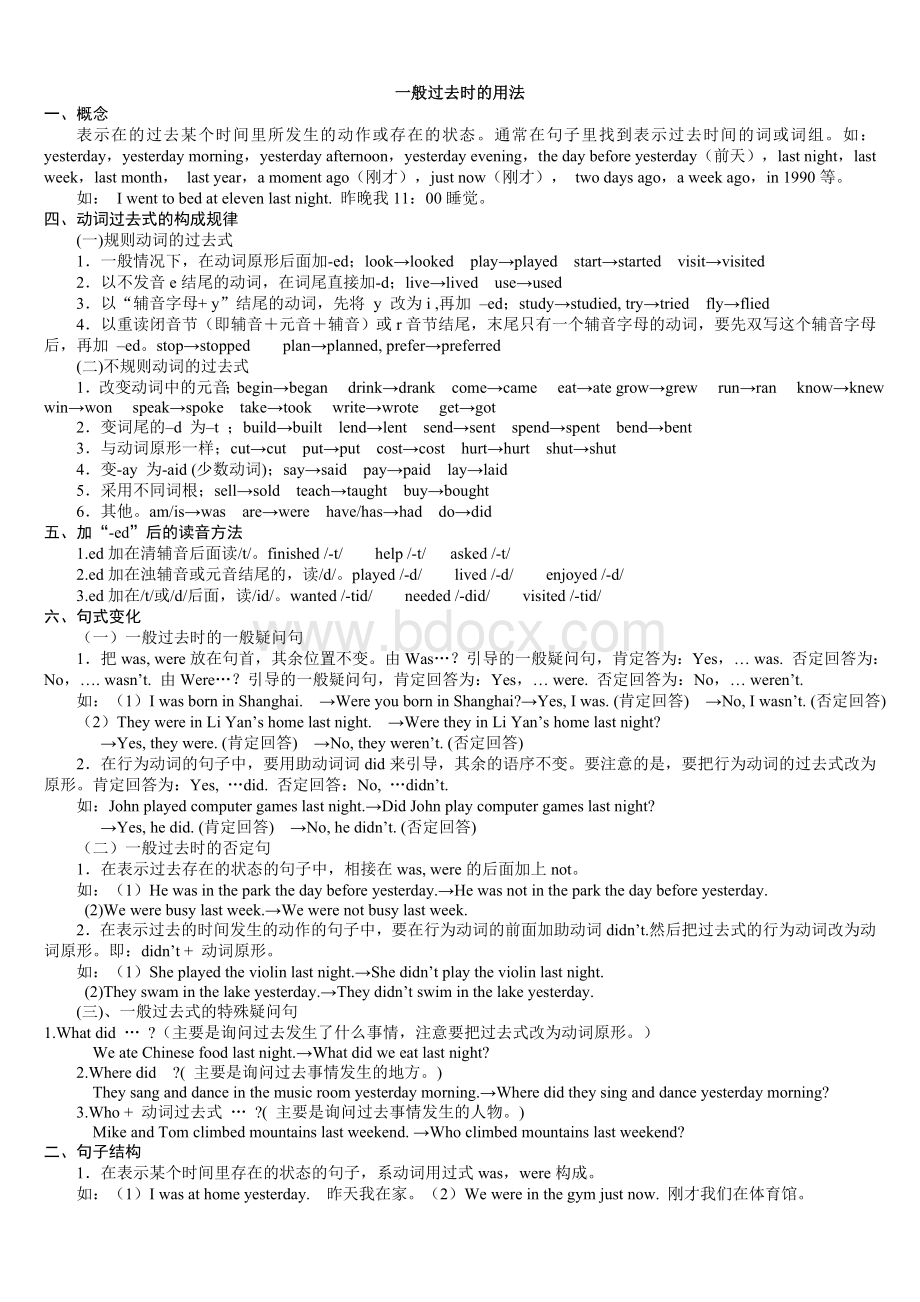小学六年级英语【一般过去时的用法】现在进行时Word格式.doc
《小学六年级英语【一般过去时的用法】现在进行时Word格式.doc》由会员分享,可在线阅读,更多相关《小学六年级英语【一般过去时的用法】现在进行时Word格式.doc(2页珍藏版)》请在冰豆网上搜索。

study→studied,try→triedfly→flied
4.以重读闭音节(即辅音+元音+辅音)或r音节结尾,末尾只有一个辅音字母的动词,要先双写这个辅音字母后,再加–ed。
stop→stopped plan→planned,prefer→preferred
(二)不规则动词的过去式
1.改变动词中的元音;
begin→began drink→drankcome→came eat→ategrow→grew run→ran know→knewwin→won speak→spoke take→took write→wrote get→got
2.变词尾的–d为–t;
build→builtlend→lentsend→sentspend→spentbend→bent
3.与动词原形一样;
cut→cutput→putcost→costhurt→hurtshut→shut
4.变-ay为-aid(少数动词);
say→saidpay→paidlay→laid
5.采用不同词根;
sell→soldteach→taughtbuy→bought
6.其他。
am/is→wasare→werehave/has→haddo→did
五、加“-ed”后的读音方法
1.ed加在清辅音后面读/t/。
finished/-t/help/-t/asked/-t/
2.ed加在浊辅音或元音结尾的,读/d/。
played/-d/lived/-d/enjoyed/-d/
3.ed加在/t/或/d/后面,读/id/。
wanted/-tid/needed/-did/visited/-tid/
六、句式变化
(一)一般过去时的一般疑问句
1.把was,were放在句首,其余位置不变。
由Was…?
引导的一般疑问句,肯定答为:
Yes,…was.否定回答为:
No,….wasn’t.由Were…?
引导的一般疑问句,肯定回答为:
Yes,…were.否定回答为:
No,…weren’t.
(1)IwasborninShanghai.→WereyouborninShanghai?
→Yes,Iwas.(肯定回答)→No,Iwasn’t.(否定回答)
(2)TheywereinLiYan’shomelastnight.→WeretheyinLiYan’shomelastnight?
→Yes,theywere.(肯定回答)→No,theyweren’t.(否定回答)
2.在行为动词的句子中,要用助动词词did来引导,其余的语序不变。
要注意的是,要把行为动词的过去式改为原形。
肯定回答为:
Yes,…did.否定回答:
No,…didn’t.
Johnplayedcomputergameslastnight.→DidJohnplaycomputergameslastnight?
→Yes,hedid.(肯定回答)→No,hedidn’t.(否定回答)
(二)一般过去时的否定句
1.在表示过去存在的状态的句子中,相接在was,were的后面加上not。
(1)Hewasintheparkthedaybeforeyesterday.→Hewasnotintheparkthedaybeforeyesterday.
(2)Wewerebusylastweek.→Wewerenotbusylastweek.
2.在表示过去的时间发生的动作的句子中,要在行为动词的前面加助动词didn’t.然后把过去式的行为动词改为动词原形。
即:
didn’t+动词原形。
(1)Sheplayedtheviolinlastnight.→Shedidn’tplaytheviolinlastnight.
(2)Theyswaminthelakeyesterday.→Theydidn’tswiminthelakeyesterday.
(三)、一般过去式的特殊疑问句
1.Whatdid…?
(主要是询问过去发生了什么事情,注意要把过去式改为动词原形。
)
WeateChinesefoodlastnight.→Whatdidweeatlastnight?
2.Wheredid?
(主要是询问过去事情发生的地方。
Theysanganddanceinthemusicroomyesterdaymorning.→Wheredidtheysinganddanceyesterdaymorning?
3.Who+动词过去式…?
(主要是询问过去事情发生的人物。
MikeandTomclimbedmountainslastweekend.→Whoclimbedmountainslastweekend?
二、句子结构
1.在表示某个时间里存在的状态的句子,系动词用过式was,were构成。
(1)Iwasathomeyesterday. 昨天我在家。
(2)Wewereinthegymjustnow.刚才我们在体育馆。
2.在表示过去某个时间里发生的动作,用动词的过去式构成。
Ivisitedmyuncleyesterday.昨天我拜访了我的叔叔。
3.各种句式
(1)一般过去时的肯定陈述句:
主语+动词过去式+宾语或表语。
HeworkedinShanghaitenyearsago.
(2)一般过去时的否定句:
a.主语+didn’t+动词原形+宾语。
(did+not=didn'
t)
Hedidn'
tdomorningexercisesyesterday.
b.主语+wasn’t/weren’t+表语。
(was+not=wasn'
twere+not=weren'
Hewasn'
tanEnglishteachertenyearsago.
(3)一般过去时的一般疑问句:
a.Did+主语+动词原形+宾语?
DidyoustudyEnglishin1990?
b.Was/Were+主语+表语?
Washeapupilfiveyearsago?
(4)一般过去时的特殊疑问句:
a.特殊疑问词+did+主语+动词原形+宾语?
Wheredidyourparentslivefiveyearsago?
WhatdidyoudolastSunday?
b.特殊疑问词+were/was+表语?
Whowasatthezooyesterday?
现在进行时态的练习
通常在句子中有以下的词:
now,look,listen.
句子的结构如下:
beam
is+动词ing
are
1.Iamlisteningtothemusicnow.
2.Thestudentsaredrawingpicturesnow.
3.Listen!
Sheissinging.
4.Look!
MrLiisridingabike.
其中,动词的ing形式有如下方法:
A.在动词后直接加ing:
go-going,wash-washing,fly—flying
B.以单个元音+单个辅音+e结尾,去掉e加ing,如:
drive—driving,ride--riding
C.某些单词要双写词尾的字母:
swim-swimmingrun—running
练习:
1.MrZheng(read)abooknow.
2.Therabbits(jump)now.
3..Look!
TomandJohn(swim).
4.Mybrother(make)akiteinhisroomnow.
5.Look!
Thebus(stop).
6.We(have)anEnglishclassnow.
7.Listen!
Someoneis(come).
8.They(catch)butterfliesnow.
9.He(do)anexperimentnow.
10.They(collect)stampsnow.
11.Look!
He(dive)now.
12.Tom(watch)TVinthediningroom.
13.Thedoctors(get)offthebus.
14.Comeon.They(leave)now.
15.It(eat)fishnow.
16.Myfather(work)intheoffice